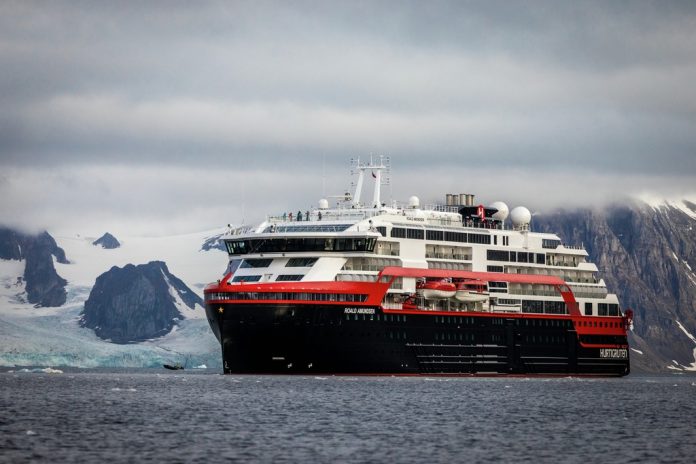Viking Expeditions will begin sailing in January 2022 with Viking Octantis on voyages to Antarctica and North America’s Great Lakes.
Viking Polaris will follow in August 2022, sailing to Antarctica and the Arctic.
These distinctive vessels have straight bows, longish hulls, fin stabilizers and, to reduce roll when stationary, novel U-tank stabilizers.
Making exploration comfortable
After keeping its expedition product under wraps for many months, Viking revealed the pair of sleek 378-passenger ships that have been under construction by Fincantieri’s Vard. They’ll measure 30,150gt and stretch 205 meters/673 feet — largish for expedition vessels. But, as Viking Chairman Torstein Hagen said, that’s to ‘make exploration comfortable … One shouldn’t have to rough it on our ships.’
Viking Octantis and Viking Polaris are being built to Polar Class 6 standard and will fly the Norwegian flag, with registry in Longyearbyen, Svalbard.
The Hangar, RIBs and yellow submarines
The ships feature modern Scandinavian design and public spaces that will be familiar to Viking loyalists but are packed with novel features such as the groundbreaking rigid inflatable boats (RIBs), two 12-seat, enclosed, dual-propulsion craft that can take travelers on further-range exploration than Zodiacs.
The RIBs will launch from inside The Hangar, an enclosed, in-ship marina that enables small excursion craft to exit through multiple shell doors. An 85-foot slipway allows passengers to embark the RIBs from a flat, stable inside surface.
Each ship will have a pair of seven-person submarines — they’re yellow, Hagen noted with glee — that will not be extra-charge but included as part of the exploration product.
No helicopters, though. Hagen said they’re noisy and disruptive.
The Laboratory
Viking Octantis and Viking Polaris will also be working research vessels with a team of resident scientists. Developed in consultation with Cambridge University and other academic partners, The Laboratory will support a range of research activities. It will be equipped with wet and dry laboratory facilities, a sample processing area, fume cupboard, freezer and cool storage, comprehensive microscope optics and extensive bench space for analysis-specific instruments.
The Aula and Finse Terrace
The Aula, a stunning panoramic auditorium at the stern, will provide a venue for lectures and entertainment, with floor-to-ceiling windows and 270-degree views. Adjacent to The Aula through sliding glass walls is the Finse Terrace, an outdoor lounge area with couches and warming lava rock ‘firepits.’
Nordic Balcony
All cabins feature a Nordic Balcony, a sunroom that converts into an alfresco viewing platform. The floor-to-ceiling glass flush with the edge of the ship lets passengers take in the views while keeping the elements out. The top of the panoramic glass lowers to transform the room into a sheltered lookout, with an observation shelf at elbow level to stabilize binoculars or a camera.
There are six cabin categories, ranging from 222 square feet to 1,223 square feet. All have a drying closet for expedition gear.
13-day polar voyages
Most of the polar voyages stretch 13 days. Examples are ‘Antarctic Explorer,’ from Buenos Aires to Ushuaia, with inaugural pricing starting at $14,995 per person with discounted airfare from $999. ‘Actic Adventure,’ round-trip Tromsø, Norway, focuses on Svalbard. Inaugural pricing starts at $13,395 per person, with discounted airfare from $999.
The Great Lakes
Several Great Lakes itineraries, eight days, include Milwaukee to Thunder Bay, Ontario, and the reverse, and Toronto to Milwaukee. Inaugural pricing starts at $5,995 per person, with free airfare within North America. A 13-day New York-Toronto expedition transits the St. Lawrence River. Inaugural pricing starts at $8,995 per person, with free airfare within North America.
Hagen said six inaugural season voyages were opened to booking by past guests in October and sold out. All itineraries are now available for sale.

























